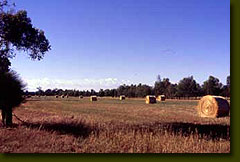Glencraig Tree Farm
 The Nursery
The Nursery
The species planted are all Australian Eucalypts, Melaluecas, Casuarina (sheoaks) and several lower understory species. All seedlings are Australian species suitable for on farm planting, which is important as farmers are often misinformed by the popular opinion of Government Departments and Landcare officers, leading to unsuitable species being planted.
In the first year of operation in 1989 approximately 1800
eucalypts, mainly saw log species were planted (at the time
this seemed an overwhelming number). Between 1992 and
2004 the nursery has been expanded five times and today
produces over 100,000 seedlings for sale within the region.

 The Seedlings
The Seedlings
The lowest cost component for the nursery is the seed. Many species have on average 500-1000 viable seeds per gram. After germination which usually takes from 10-14 days seedlings are pricked out to leave only the most viable and healthy seedling to grow out in each cube. This process provides an employment opportunity for three or four local people.
By mid-June seedlings are ready to plant out in the paddock. It has been found that seedlings planted after the shortest day (June 21) have a greater survival rate due to the increase in day length. By the end of July all trees would be expected to have been planted at which time the nursery is packed up and sprayed until the following January when planting commences again.
 Landcare
Landcare
Glencraig has over 130 ha (320 acres) of natural bush fenced off, however without water management on the remainder of the farm or neighbouring land over half of this would be under threat. Using common sense, local knowledge and technical assistance from several officers from the Department of Agriculture, the change to a more sustainable, enjoyable and profitable farming system was made in 1989.
Low lying poorly drained flat valley floors have been planted using wide spaced alley farming and drainage. Contours of shallow drains, rows of trees and the re-alignment of fences have enabled excess water to be harvested into dams which overflow into grassed water ways and then into defined natural water courses to leave the farm in a filtered and orderly manner.
The need to establish a tree growing facility on the farm arose from this change in farming system, as it required a large number of trees at an affordable price. As interest in Landcare grew, more trees were planted. As well providing farm trees for sale, many seedlings have been given away to support local landcare initiatives.


